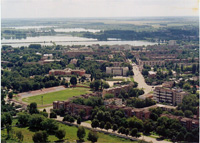By Robert S. Sherins
Vice-president, Polish Genealogy Society of California
March 25, 2004
 There are several versions of the origin of the town named Konotop, (aka Konotip). The exact date of first inhabitation is not known, but the Siveriany Tribe settled there during the middle ages, possibly from the 6th century.
There are several versions of the origin of the town named Konotop, (aka Konotip). The exact date of first inhabitation is not known, but the Siveriany Tribe settled there during the middle ages, possibly from the 6th century.
They were involved in agriculture. A second version of the origin dated from the time of the Kievan Rus in the 12th century. Pottery shards of the type made by the Kievan Rus have been discovered in excavations near Konotop, which indicated early Kievan Rus inhabitation of the region. Another version began in the 13th century when the Tatars called the place Konotople because of the swamps, where many invaders had died during the invasion of Russia.
According to the Polish historical version, Konotop was established under Polish rather than Russian rule. Historical documents about the origin of Konotop were discovered in the Archives of Warsaw. Those documents were given to the Konotop museum in 1965. They revealed that Wladislaw IV Vasa, son of King Sigismund III, gave Mikola Cetisotu the regional lands of Konotop, which included the towns of Konotop, Gorodische, and Ezuch, for “services rendered to the Crown.”
Poland and Lithuania were united by the Union of Lublin in 1569. That “Act” was known as the Rzeczpospolita (pronounced Zetch-pos-po-lee-ta).
Rzecz meant subject or thing. Pospolita came from the Polish root word pospolicie, which meant common or commonwealth. Poland and Lithuania formally became one country and elected one head of state with the title of King. There was one Parliament, the Sejm Walny, located in Warsaw, one currency, and one foreign policy. Poles, Ruthenians, and Lithuanians could settle anywhere in the Republic.
The Union of Lublin was the direct result of the marriage in 1386 of Jagiello, Grand Duke of Lithuania, and Jadwiga, King (Queen) of Poland.
Jadwiga was the daughter of Louis of Anjou, King of Hungary. When Kazimierz III, former King of Poland died, he had no heirs. Louis of Anjou was the closest male relative (nephew) of Kazimierz and, therefore, became the new King of Poland. Louis of Anjou had a daughter, Jadwiga, who succeeded him as Queen of Poland, but she was crowned as King of Poland because there was no official designation of “Queen” in Poland. Jadwiga reigned from 1384—1399, but married Jagiello in 1386. As a result of that marriage, two kings reigned simultaneously in Lithuania-Poland.
In 1634, the date that Konotop was founded, Wladislaw IV Vasa became King of Poland and Grand Duke of Lithuania. Wladislaw IV Vasa (Ladislau IV) was the son of Sigismund III Vasa, who held three titles: Titular King of Sweden, Emperor and Titular King of Moscovy,ii and King of Poland-Lithuania. The Polish-Lithuanian kingdom was aligned by marriage with the Swedish House of Vasa. The Vasa dynasty in Poland started with Zygmunt Stary (old), whose daughter, Katherine, married Jan III Vasa, King of Sweden.
In 1386, Archduke Vytautas (Witold) of Lithuania conquered Belarus, Russia, and Ukrainian territories as far south as the Black Sea. From 1610—1612, Poland-Lithuania briefly occupied Moscow. Western European powers were embroiled in the Thirty-Years War, which devastated Europe from 1618 to 1648. The first Romanov Czar, Michael, assumed that Wladislaw IV would be preoccupied with his marriage and new kingdom, and distracted by the continuation of the Thirty-Years War in Europe. The borders between Russia and Poland-Lithuania were advanced and then retracted multiple times during the period of the 13th to 17th centuries. Czar Michael decided to invade Poland-Lithuania in 1634 to take back the territories previously ruled by Russia. Wladislaw had just become king and before his military forces were well organized. However, King Wladislaw IV repelled the invading Russian military forces.
Добавить комментарий
Для отправки комментария вам необходимо авторизоваться.